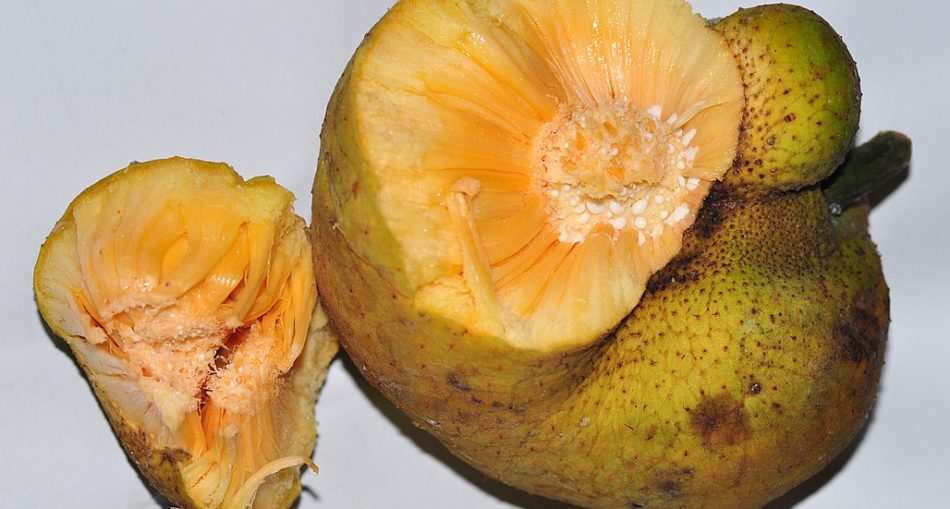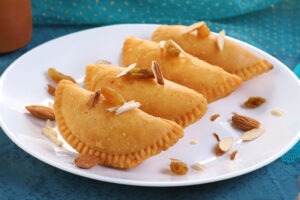You may have heard of monkey apple, but what about monkey fruit? In Guyana, it is known as badahar and is similar to breadfruit. The scientific name of the fruit is Artocarpus lacucha. Badahar plants are evergreen and are widely distributed in the Indian subcontinent and in tropical areas. Since it is a popular fruit growing all over the world, it goes by different names. The Hindi name of badahar is lakoocha, while the English name is monkey fruit, and in Mayla it is called Tampang. Guyana and Nepal share the name of monkey fruit – badahar. Badahar is not a popular fruit even in Guyana, with many Guyanese not knowing of the existence of this sweet, tart fruit.
Origin of the Badahar Fruit
Badahar originated in India and slowly spread to the Southeast subcontinent in Asia to include Bhutan, Guyana, Nepal, Sri Lanka, Bangladesh, Singapore, Vietnam and Cambodia. The badahar plant has been widely used as food and medicine, providing lots of health benefits. It has anti-oxidant, anti-inflammatory and purging qualities. Some byproducts of the badahar plant are firewood for fuel, timber, dye and fodder for animals. We not only make use of the fruit but many parts of the stem, making badahar a valuable plant to have.
Description of Badahar
The Badahar tree is an evergreen or deciduous plant with gray bark that grows as high as fifteen (15) metres. Its plants grow in a variety of places such as the open countryside, forests and in villages leading up to mountain tops. The badahar plant thrives in well-drained soils especially those with a good water supply. It has branches about three (3) to six (6) millimetres thick, covered in yellow to brown leaves about twenty-five to thirty centimetres (25-30 cm) long, and fifteen to twenty centimetres (15-20 cm) wide. While the flowers of the badahar plant are unisexual, meaning the flower can only have the stamen or carpel, they grow on the same tree. The female flowers are reddish in colour and the males, a yellow-orange. An entire female inflorescence forms the fruit, which is a dull green or yellow colour. The fruits are typically two to five (2-5) inches wide and weigh about two hundred to three hundred and seventy kilograms (200-370 kg.) Badahar has a brownish colour when it is fully ripe and has a pleasant, sweet, tangy taste. The badahar fruit typically has ten to thirty (10-30) seeds which differ in size.
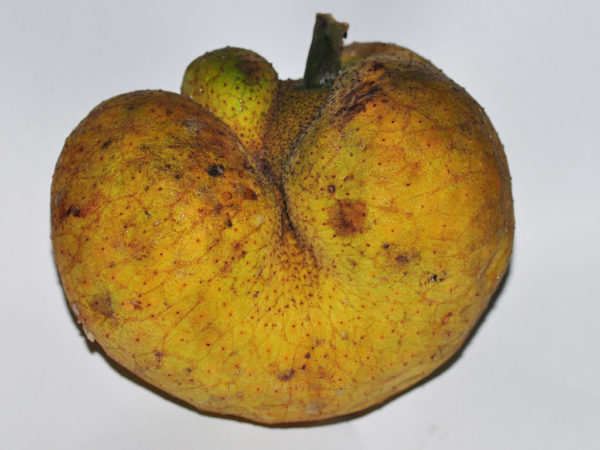
A Badahar fruit | Photo by Balaram Mahalder [CC BY-SA (https://creativecommons.org/licenses/by-sa/3.0)]
Nutritional Value
The average Badahar fruit contains about seventy-three (73) calories, 2g protein, 1 g fat, 1 g mineral, 3 g fibre, 67 mg calcium and 25 mg phosphorous.
Traditional Uses of Badahar
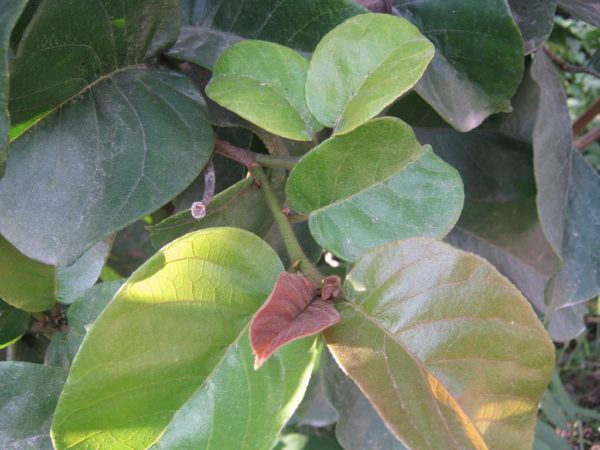
Leaves of a Badahar plant – | By Krish Dulal – Own work, CC BY-SA 3.0, https://commons.wikimedia.org/w/index.php?curid=22064372
- Bark – This is used to treat skin lesions while the powder from the bark is used to reduce abscesses and cure wounds. It is also useful for stomach and liver diseases. The softened or pulp of the bark is used for treating headaches. The sap and juice of the bark can be applied on boils and pimples as well.
- Seed – A great laxative especially for children and also treats liver and stomach diseases.
- Fruit – Badahar is very nutritious and can even be used to fight malnutrition.
- Fruit extract – The extract made from the badahar fruit stimulates hair growth and reduces hair fall and improves skin conditions like darkening.
Health Benefits of Badahar
- Disease Prevention – When properly eaten, the badahar fruit prevents a number of diseases according to study. It prevents diseases such as diabetes, cancer, coronary heart diseases and neurodegenerative ailments.
- Effects – This plant has several immunity properties such as antibacterial, antioxidant and reducing inflammation and has overall health improving benefits to the human body.
- Cleansing – Eating the badahar fruit purges the body and refreshes the liver.
- Nutritious – This fruit is full of nutrients and is even used to prevent malnutrition.
Culinary Uses of Badahar
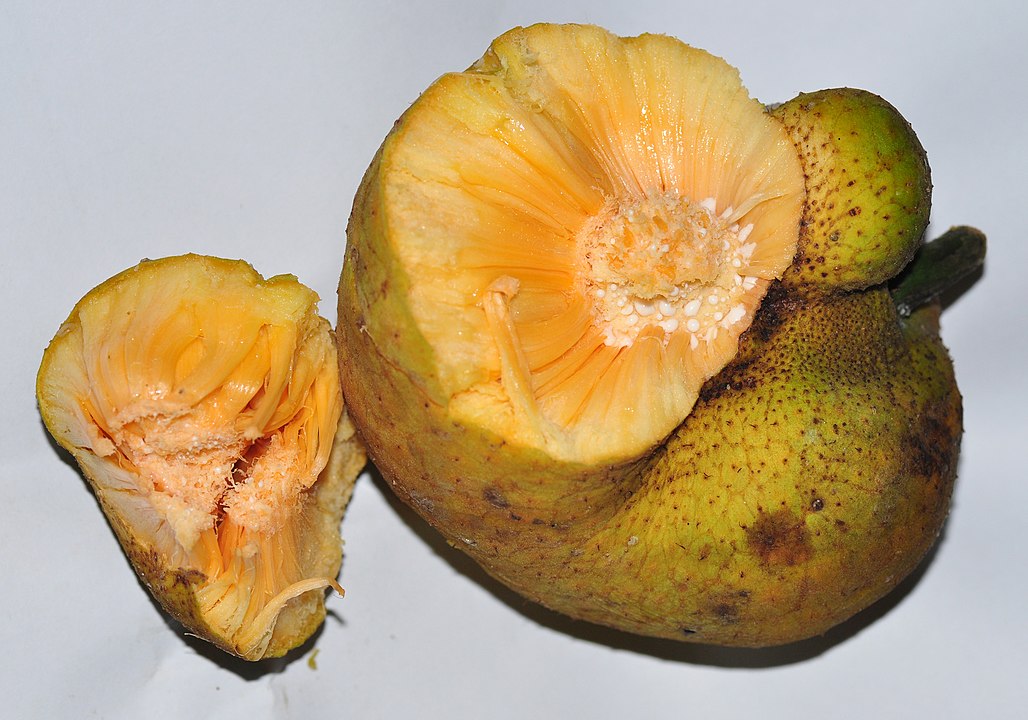
A look inside the badahar fruit | By Balaram Mahalder – Own work, CC BY-SA 3.0, https://commons.wikimedia.org/w/index.php?curid=15435523
- The fruits are usually tart when eaten fresh and can be made into curries.
- The green or unripe fruits and male flowers are used in pickles, curries and sauces.
- The flat and broad seeds can be eaten too.
- The bark of badahar can be used as an alternative to betel nut.
Other uses of Badahar
- Decoration: The plant can also be grown as a decoration.
- Dye: Due to the tannin contained inside, the roots and wood produce a dye.
- Fodder: This is considered a very valuable forage at the foothills of the Himalayas mountains because they have about sixteen percentage (16% ) protein. They have a production rate of about sixty (60) to two hundred (200) kilograms per year.
- Fuel: The wood or branches of the badahar plant can be used for firewood.
- Lipids: The plant also produces a kind of light yellow fat.
- Rubber: A sticky latex is present in all parts of the tree and has many uses.
- Shelter: The trees provide humans, plants and animals with shade and shelter from the different elements of weather.
- Timber: The wood from badahar trees is used in the construction of beams, boats, plywood and heavy construction because of its termite resistance.
Interesting Facts about Badahar
- The word ‘badahar’ is the Nepali.
- The dye obtained from the plant is used to colour textiles.
- The trees are sometimes used for shelter by humans, birds and other animals.
About Badahar
The badahar fruit may not be popular however it boasts of many healthy properties. In addition to being a delicious snack, this fruit cleanses your body and improves health. Since it is not widely known, finding the fruit may prove a bit of a challenge in Guyana but you will see it is definitely worth it if you manage to get your hands on it.
Article References
- https://www.healthbenefitstimes.com/monkey-fruit/
- https://hort.purdue.edu/newcrop/ncnu02/v5-405.html
- https://www.researchgate.net/publication/290438301_Nutritional_value_and_medicinal_uses_of_Monkey_Jack_fruit_Artocarpus_lakoocha
- Main Image: By Balaram Mahalder – Own work, CC BY-SA 3.0, https://commons.wikimedia.org/w/index.php?curid=15435523

